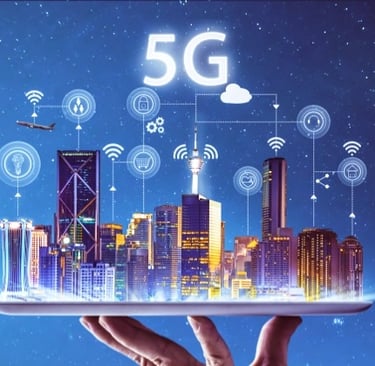🕵️♂️Get Up to 80% Off On All Products, StaySharp⚡
5G Technology: Opportunities and Challenges for Developers
Learn how 5G opens new possibilities for app development and IoT innovations, and understand the challenges like security risks and infrastructure inconsistencies
CYBERSECURITY
Phillemon Neluvhalani
4/19/20242 min read


The rollout of 5G technology marks a monumental shift not just for mobile phone users but also for developers across the globe. Promising significantly faster data speeds, reduced latency, and increased connectivity, 5G could redefine the parameters of what’s possible in mobile and web development. However, as with any technological advancement, it brings its own set of challenges alongside its exciting opportunities. Let's delve into how this next generation of wireless technology is poised to reshape the development landscape.
Opportunities Unleashed by 5G
1.Enhanced Mobile Experiences
With speeds theoretically up to 100 times faster than 4G, 5G opens up new realms of possibilities for developers. Apps that incorporate video streaming, augmented reality (AR), and virtual reality (VR) can operate more smoothly and with higher quality. This enhancement is not just about speedier downloads but also about richer, more immersive user experiences without frustrating lags or buffering.
2.IoT and Smart Cities
5G's ability to support a vastly greater number of connected devices per square kilometer is a game-changer for the Internet of Things (IoT). Developers can now create more complex networks of interconnected devices and applications. From smart traffic lights that communicate with cars to more sophisticated and responsive smart home systems, the IoT landscape is set to expand dramatically under 5G.
3.Innovations in Health Tech
The low latency of 5G is crucial for medical applications. For developers, this means there are opportunities to work on real-time remote medical diagnostics and treatments, such as telesurgery, where even a millisecond’s delay can be critical. The potential for life-saving innovations in health tech will be significant as 5G becomes more widespread.
Challenges Facing Developers
1.Security Risks: With an increased number of devices connected to the internet and each other, the potential entry points for security breaches multiply. 5G networks, like their predecessors, will likely be targeted by cyberattacks. Developers will need to prioritize security in their designs, ensuring that robust encryption and other security measures are built in from the ground up.
2.Infrastructure and Coverage Inconsistencies: While 5G promises widespread benefits, the reality is that the rollout will be uneven across different regions. Developers will need to design applications that are just as functional on 4G to accommodate areas where 5G is slow to deploy. This requires maintaining a delicate balance between leveraging new capabilities and ensuring accessibility.
3.Upgrading and Compatibility Issues: The shift to 5G requires developers to update existing applications to exploit the full potential of the new network. However, ensuring compatibility with older devices and networks can complicate this transition. Developers must consider whether they design primarily for the leading edge, potentially alienating a segment of the market, or for broader compatibility, possibly underutilizing 5G’s capabilities.
As developers, embracing 5G technology means being at the forefront of the next wave of digital transformation. It requires not only technical skill but also foresight and adaptability. Staying informed and responsive to the evolving tech landscape, engaging in continuous learning, and collaborating across industries will be key to unlocking the full potential of 5G.
While the path forward may be fraught with challenges, the opportunities are both vast and inspiring. As we continue to innovate and adapt, the impact of 5G on our digital world promises to be profound, ushering in new eras of connectivity and technological advancement.


